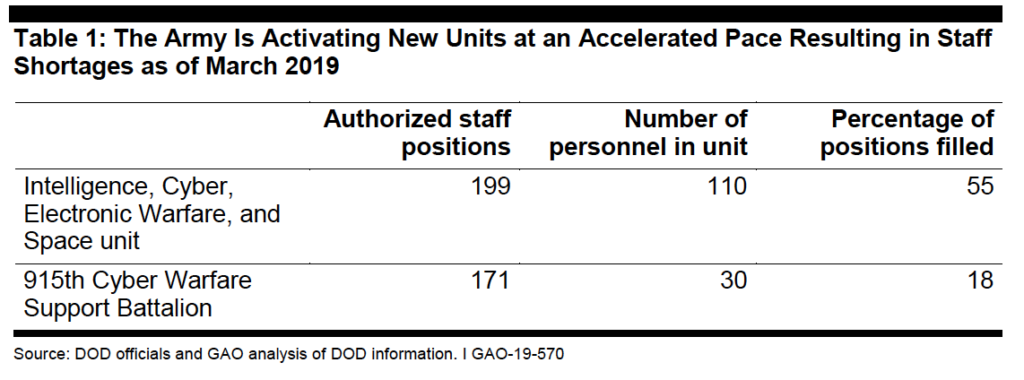By SYDNEY J. FREEDBERG JR.
 WASHINGTON: Two elite Army cyber/electronic warfare units — critical components of its plans for high-tech war — have struggled to fill their ranks, the Government Accountability Office reported Thursday. As of March, only 18 percent of the required personnel were in place at the 915th Cyber Warfare Support Battalion (CWSB) in Fort Gordon, Ga. On the opposite coast, at Fort Lewis, Wa., the Intelligence, Information, Cyber/Electronic Warfare, & Space (I2CEWS) battalion had managed to reach 55 percent manning, up from 32 percent at its creation in October last year.
WASHINGTON: Two elite Army cyber/electronic warfare units — critical components of its plans for high-tech war — have struggled to fill their ranks, the Government Accountability Office reported Thursday. As of March, only 18 percent of the required personnel were in place at the 915th Cyber Warfare Support Battalion (CWSB) in Fort Gordon, Ga. On the opposite coast, at Fort Lewis, Wa., the Intelligence, Information, Cyber/Electronic Warfare, & Space (I2CEWS) battalion had managed to reach 55 percent manning, up from 32 percent at its creation in October last year.
Of course, the GAO data is out of date. Have things improved? So far, I haven’t gotten updated figures from the Army, nor any official statement on the report. But the informal, off-record reaction I’ve heard from people in the Pentagon boils down to: Really?
It’s no surprise that creating a new capability from nothing is a tricky process. And highly technical cyber talent is in short supply, not just in the Army, but across the government and indeed the global economy. The Army is ramping up its training pipeline, but it didn’t want to hold off on creating new units to test out new high-tech ways of war.

Two new elite Army cyber/electronic warfare units struggled to fill their ranks, GAO reported.
In fact, across its Big Six modernization program, instead of trying to analyze the problem to death in the abstract, the Army has embraced a Nike-like “just do it” attitude where they get new units, technology, and tactics in the field as fast as possible to test them out in the real world and figure out what works, what won’t, and what needs to be changed. Army officials are understandably exasperated that GAO, the Hermione Granger of the federal government, is now nitpicking them for not doing enough analysis beforehand.
Indeed, it’s a remarkable and refreshing change of pace for the Army to come under criticism for moving too fast. For decades, the service’s problem has been moving too slowly — or attempting ambitious great leaps forward that got nowhere because they proved impractical and died during prolonged, painful development. Now the Army is actually making things happen, accepting the inevitable flaws and trying to “fail fast” like a Silicon Valley firm trying out new tech.
In this particular case, these are new units to take on new missions as the Army refocuses from counterinsurgency in Afghanistan and Iraq to high-tech confrontations with Russia and China. The awkwardly named I2CEWS detachment in particular is considered a pilot or prototype unit, which — as the GAO report acknowledges — exempts it from the usual risk-assessment reviews the Army conducts before standing up new formations. The Cyber Warfare Support Battalion technically isn’t experimental, but it’s still the first battalion of its kind in the history of the Army.
For a half century, DRS has provided military forces around the world with advanced technologies and capabilities to meet their mission needs. Here are some highlights.
From LEONARDO DRS
So the whole point of creating these new formations is to figure out what skillsets, equipment, and organizations they need to do their missions, because it’s never been done before.
All that said, GAO does have a point: The Army can’t execute new concepts if it doesn’t have the people to do them yet.
“We think the Army experimenting in this way is fine given the sense of urgency and the threats,” GAO defense studies director John Pendleton told me. “However, the Army will likely run into some of the same staffing, training, and equipping challenges as it stands up additional types of units on an accelerated basis. A risk assessment would help head that off since they plan to stand up new units in the relatively near term.
“Going forward, the Army needs to be realistic with their goals and expectations given some of the realities they face in terms of staff shortages and the need to develop equipment and training,” Pendleton said. “Additional study wouldn’t ‘solve’ the under-manning problem, but a full, clear-eyed assessment of the ability to staff, equip, and train the units would give the Army a sense of whether its plans were realistic over the expected timeframe.”
No comments:
Post a Comment